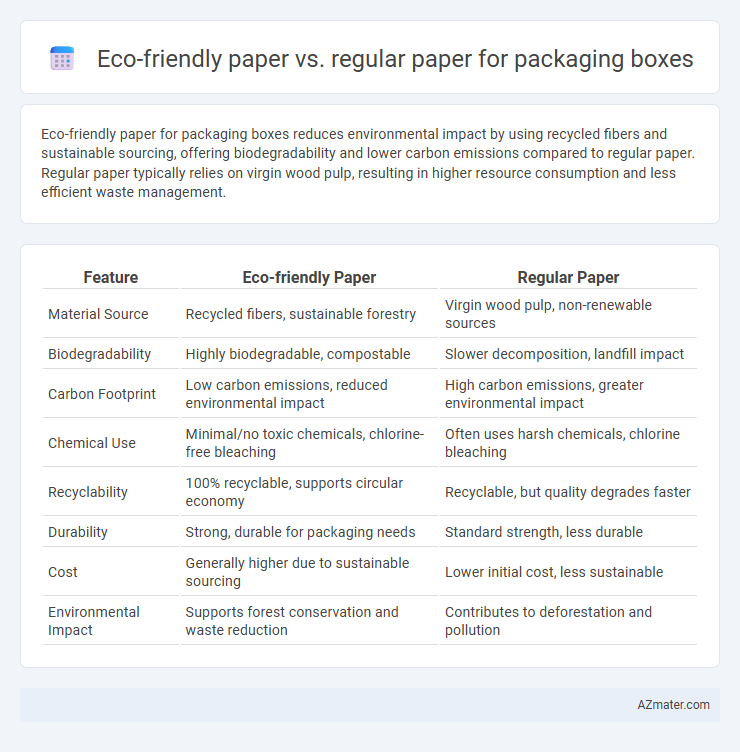Eco-friendly paper for packaging boxes reduces environmental impact by using recycled fibers and sustainable sourcing, offering biodegradability and lower carbon emissions compared to regular paper. Regular paper typically relies on virgin wood pulp, resulting in higher resource consumption and less efficient waste management.
Table of Comparison
| Feature | Eco-friendly Paper | Regular Paper |
|---|---|---|
| Material Source | Recycled fibers, sustainable forestry | Virgin wood pulp, non-renewable sources |
| Biodegradability | Highly biodegradable, compostable | Slower decomposition, landfill impact |
| Carbon Footprint | Low carbon emissions, reduced environmental impact | High carbon emissions, greater environmental impact |
| Chemical Use | Minimal/no toxic chemicals, chlorine-free bleaching | Often uses harsh chemicals, chlorine bleaching |
| Recyclability | 100% recyclable, supports circular economy | Recyclable, but quality degrades faster |
| Durability | Strong, durable for packaging needs | Standard strength, less durable |
| Cost | Generally higher due to sustainable sourcing | Lower initial cost, less sustainable |
| Environmental Impact | Supports forest conservation and waste reduction | Contributes to deforestation and pollution |
Introduction to Paper Packaging Materials
Eco-friendly paper packaging materials are derived from sustainable sources, often incorporating recycled fibers and biodegradable components that reduce environmental impact. Regular paper packaging typically relies on virgin wood pulp, requiring higher energy consumption and contributing to deforestation and waste accumulation. Choosing eco-friendly paper for packaging boxes supports resource conservation and aligns with growing consumer demand for sustainable product solutions.
What is Eco-Friendly Paper?
Eco-friendly paper for packaging boxes is produced using sustainable materials, such as recycled fibers or responsibly sourced wood pulp, minimizing environmental impact. It often involves processes that reduce water, energy consumption, and harmful chemicals compared to regular paper manufacturing. This sustainable approach helps decrease deforestation, carbon emissions, and waste, making eco-friendly paper a preferred choice for environmentally conscious brands.
Regular Paper: Composition and Production
Regular paper used for packaging boxes primarily consists of wood pulp derived from softwood and hardwood trees, with chemical additives such as fillers, sizing agents, and bleaching chemicals to enhance strength, brightness, and printability. The production process involves mechanical and chemical pulping, followed by pressing, drying, and coating stages that consume significant water and energy resources, contributing to environmental pollution. This conventional manufacturing method often results in higher carbon emissions and lower recyclability compared to eco-friendly alternatives.
Environmental Impact of Eco-Friendly Paper
Eco-friendly paper for packaging boxes significantly reduces environmental impact by utilizing recycled fibers, reducing deforestation, and lowering carbon emissions during production. Its biodegradable properties minimize landfill waste compared to regular paper, which often contains synthetic additives and coatings that hinder decomposition. Sustainable sourcing and energy-efficient manufacturing processes make eco-friendly paper a key component in reducing the overall ecological footprint of packaging solutions.
Environmental Impact of Regular Paper
Regular paper used for packaging boxes contributes significantly to deforestation and high energy consumption during production, resulting in increased greenhouse gas emissions. The chemical-intensive bleaching process releases harmful pollutants into water systems, exacerbating environmental degradation. Moreover, conventional paper's slow decomposition in landfills leads to prolonged waste accumulation and methane emissions, intensifying its ecological footprint compared to eco-friendly alternatives.
Cost Comparison: Eco-Friendly vs Regular Paper
Eco-friendly paper for packaging boxes often incurs higher initial costs compared to regular paper due to sustainable sourcing and environmentally responsible production processes. Despite the higher upfront expense, eco-friendly paper can result in long-term savings through reduced waste management fees and potential tax incentives for sustainable practices. Regular paper typically offers lower purchase prices but may lead to increased environmental compliance costs and less favorable brand perception among eco-conscious consumers.
Durability and Strength in Packaging Applications
Eco-friendly paper for packaging boxes offers comparable durability and strength to regular paper while significantly reducing environmental impact through sustainable sourcing and biodegradable materials. Its high tensile strength and resistance to tearing ensure reliable protection for products during transportation and handling. Innovations in eco-friendly coatings and fiber blends enhance moisture resistance and structural integrity, making them suitable alternatives for demanding packaging applications.
Consumer Perception and Market Trends
Eco-friendly paper packaging boxes are increasingly favored by consumers due to growing environmental awareness and demand for sustainable products, influencing positive brand perception and purchasing decisions. Market trends indicate a significant shift towards biodegradable and recycled paper materials, driven by regulations and corporate sustainability goals, enhancing market competitiveness. Consumer preference for eco-friendly options is reflected in higher willingness to pay a premium, fostering innovation in sustainable packaging solutions.
Sustainability Certifications and Standards
Eco-friendly paper used in packaging boxes often holds sustainability certifications such as FSC (Forest Stewardship Council) and PEFC (Programme for the Endorsement of Forest Certification), ensuring responsible forest management and reduced environmental impact. In contrast, regular paper typically lacks these certifications, contributing to deforestation and higher carbon footprints. Choosing certified eco-friendly paper supports sustainable forestry practices and enhances compliance with global environmental standards like ISO 14001.
Choosing the Right Paper for Packaging Needs
Eco-friendly paper for packaging boxes offers sustainable benefits like biodegradability and reduced carbon footprint compared to regular paper, which often relies on non-renewable resources and chemical treatments. Selecting the right paper depends on factors such as durability, print quality, cost, and environmental impact, where recycled or FSC-certified paper options balance performance and eco-consciousness. Brands aiming to enhance their green credentials should prioritize eco-friendly paper that meets packaging strength requirements without compromising on visual appeal.

Infographic: Eco-friendly paper vs Regular paper for Packaging box
 azmater.com
azmater.com